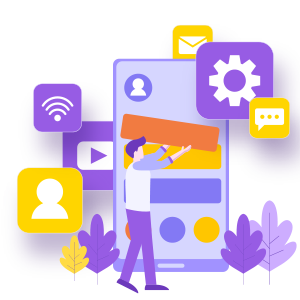You’ll be on the right path if you think about digital transformation as a state of perpetual agility, always ready to evolve in response to what your customers want next,” – said Google Cloud Platform Vice President and Head Amit Zavery.
The topic of our blog is a good example of this expression.
You will discover the upcoming mobile app development trends to follow in 2024 by reading this blog. Your online competitors will be unable to compete with you. Now that we are nearing the end of 2022, let’s make sure we are prepared!
In this blog, you will find a comprehensive list of 11 hot mobile app development trends for 2024.
Trends in the market
You can reach potential customers and maximize operational efficiency by developing software and mobile apps. Approximately $614.40 billion will be generated by mobile apps by 2026. In addition to the potential revenue, there is a massive responsibility to adapt to changing market standards.
Even though app solutions have been the one-stop destination for end customers for over a decade, technologies and business demands continue to evolve at an exponential rate. Consequently, mobile app development trends become more innovative and challenging.
To ensure that you deliver nothing but the best to your clients now is the time to get your hands on the latest mobile app development trends.
You can learn how to stay ahead in the mobile app development game with this blog whether you are an entrepreneur, a business owner, a coder, an investor, or a business enthusiast.
Mobile App Development Trends for 2024:
Based on in-depth research, here are the top mobile app trends categorized into UX apps, iOS apps, and Android apps.
Several UX-based app design trends are worth mentioning:

1. Make motion design a priority
A complex and steady design that does not facilitate engagement might make your app users frustrated. Motion Design is one solution to this problem.
To grab the attention of your users, you need to “grab them down.”. Animations, scrolling, and macros help with interactivity, engagement, and macro interactions.
Carmatec improved Domino’s app’s conversion rate by 23% by incorporating motion design features.
A motion design feature in your app can also save your users’ time and direct them to a memorable experience.

2. Design with AI: The mainstream tool
Without mentioning Artificial Intelligence, it would be rather strange to examine the latest mobile UI design trends. By using AI, you can make your app interfaces by automated programs instead of hiring designers.
Alternatively, AI and machine learning can speed up design processes where massive changes are unlikely.
Because design programs mimic human decision-making processes, the results may not vary significantly. Additionally, AI is advancing slowly in the iteration of UX design beyond the basics.
A single landing page can be designed in several ways using AI, for instance.

3. App designs that are smart and inclusive
If your users don’t see themselves in the design, you can’t make them feel that your app is for them. “Rust,” a survival game in which every player’s skin color is randomly chosen, made headlines in every news blog.
The UX design decision represented all demographics, so it was a success. The hottest trends in mobile UX app design are accessibility and inclusivity, which are essential to your app’s users.

4. A touchless user interface
That’s right; you heard it right. Users of mobile apps can enjoy a touchless interface, which is an emerging trend in mobile app development. By 2024, Gartner predicts that over 50% of all major business apps will include a touchless interface.
The use of biometrics in apps, for example, to sign in or identify users, is very familiar to many users. Finance or payment apps use biometrics to confirm a user’s identity as a second authentication step.
Another mobile app trend in UI is gesture control, in which apps can be controlled by moving the head or screen. As mobile apps become more sophisticated, they will be able to track eye movements to assist in scrolling. In the near future, all of these innovations will become trends in application development.
The app design development space is bound to transform in the next few years, from simplified app design to trending AR/VR interfaces. The next step is to examine the trends in the development of iOS and Android apps.

5. Apps that focus on cameras
The number of video conferencing apps downloaded has reached 62 million at a record pace. The number of businesses choosing to develop video conference apps has skyrocketed, especially since the concept of remote working has become more prevalent. Creating social networks, sending videos, connecting with friends, and broadcasting videos are some apps users can’t get enough of.
With a market revenue of over $9.89 billion, TikTok is probably one of the most popular streaming apps.
As well as streaming entertainment niches, broadcasting niches, and social media network niches, camera-based mobile development trends are rising.

6. No code/low code
A major trend in the mobile app market is the low-code or no-code movement. You can also create interactive applications in less time with low code tools if you are a developer. It provides plug-and-play integration with other services and features, such as Zapier.
In addition, Bubble, another website, assists non-technical designers and business owners in building full web applications. Appsheet, a platform for no-code mobile apps that Google acquired recently for $60 million, is Google’s latest acquisition.
Statista found that around 40% of business owners and developers used Google Appsheet as their top low code/no code tool in 2022.

7. An audio-focused social media platform
In the social media space, video and camera-based apps are getting plenty of attention; however, audio-based apps are also gaining a lot of traction.
Over 10 million active users use Clubhouse, a conversational social media app based on audio.
The clubhouse provides a spontaneous chat experience, allowing users to jump into any chat room and join the conversation. Audio is a “meta-trend” that goes far beyond social media apps, as this app has experienced 100% growth in the past four years.

8. Apps tailored to foldable devices
As the first foldable smartphone in the US, Samsung’s Galaxy Fold was introduced in 2019. The folding RAZR was launched a few months later by Motorola. Despite holding multiple patents associated with foldable Android applications, Apple has not yet launched a foldable smartphone.
As a result of consumer demand, mobile app development is now expected to continue into 2024 and beyond. According to the Statista report, global shipments of foldable smartphones will reach 50 million units this year. As a result, this presents a unique opportunity for app developers and business owners alike.
Businesses can optimize apps specifically for foldable devices because of large screens and the ability to display multiple windows simultaneously. This innovation could revolutionize the development of mobile apps. Wearable devices follow the same trend, where you can customize your app according to the device your target audience prefers.

9. Analytics based on predictions
There have been a few times when we have discussed this mobile app development trend. By leveraging machine learning, artificial intelligence, data mining, and modeling, predictive analytics can forecast events using data.
Among the most common examples of predictive analytics in mobile apps is Netflix’s recommendation of shows based on past viewings. Mainstream adoption of predictive analytics for customer experience enhancement will take place in 2024. Within an app, it is important that no two users have the same experience.
Depending on the user’s previous behavior, you can also provide suggestions and services.
The development of mobile apps is changing dramatically with on-demand apps and Extended Reality (XR).

10. XR stands for Extended Reality
As well as AR filters and gaming interfaces (Pokemon Go), extended reality technology is popular in mobile apps.
Virtual training and onboarding processes have also begun to be used by major enterprises. By 2027, Statista predicts that the revenue from Extended Reality will reach $52 billion. A new marketing strategy for businesses is already embracing Augmented and Virtual Reality. Using XR for maximum attention and conversion, new product owners can easily introduce and enhance their services.

11. Apps available on demand
According to the Harvard business review, on-demand app development attracts more than 22 million users and generates close to $60 billion in investment. Additionally, the report highlights that the on-demand economy will continue to grow, as on-demand apps will become the future of application development.
So what does this mean for business owners and app developers? By using on-demand app development, you can meet the changing needs of your audience with a variety of features and functionalities.
As a result of their use of platforms, it is highly likely that on-demand apps will simplify the entire process of developing mobile apps.
You can make your business more visible and accessible to your target audience by choosing the right app development trend. As well as generating revenue, the above mobile app trends can establish your authority niche by fostering brand awareness.
Partnering with an experienced mobile app development company is one way to get started with your favorite mobile app trend.
What Is the Importance of Development Trends?
What’s next for mobile app development will be determined by customer expectations. The palm of the customer’s hand is where they want to socialize, work, conduct business, and be entertained. The only acceptable experience for them is a high-performance experience on the device of their choice.
Mobile app development teams should track daily active users (DAUs) and monthly active users (MAUs). Besides informing you about user engagement, this data can also help you identify areas for improvement or issues that might lead to customer churn.
According to a GitLab survey, 35% of developers are releasing code twice as fast as they were a year ago. Faster time-to-market is always paramount in mobile app development. It is easier for developers to predict outcomes and plan projects with the help of DevOps platforms, automated testing, software configuration management, and other tools. A higher release velocity is the result.
It is even more crucial that you understand how the market, technology, and user behaviour are changing.
Keep up with the latest trends with your mobile app
Apple App Store and Google Play Store combined have 5.7 million apps, according to Statista. If you had a mobile app, how would you ensure it stood out from the competition?
A mobile app development company in Qatar can’t stand out if they don’t understand the latest trends. In addition to knowing how to leverage them, you should also be aware of how to build apps that are reliable and feature-rich.
A look at the top mobile app development trends for 2024 is presented in this blog. Keep mobile, user-oriented, app security, speed, and entertainment in mind for the coming year.
In the blog, we discussed modern technologies you could create. Let Carmatec help you implement your idea using best practices in mobile apps using best practices.


